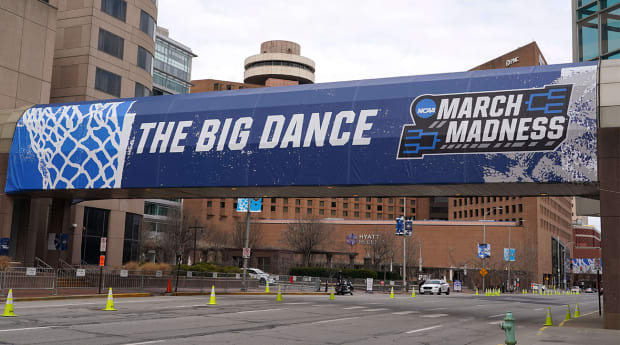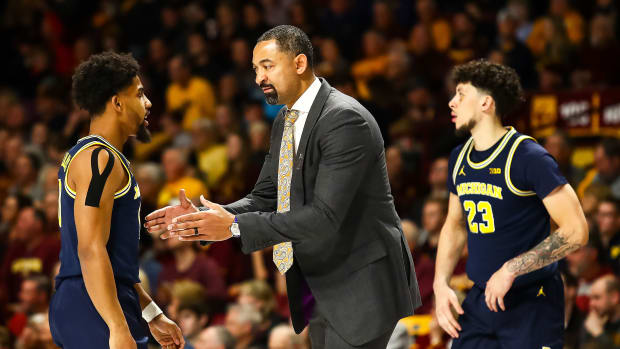Fittingly, Michigan and UCLA meet in the shadow of NCAA headquarters, a day before the NCAA goes before the Supreme Court.
INDIANAPOLIS - The walk from Lucas Oil Stadium to NCAA headquarters takes fewer than 20 minutes.
Straight up West Street for two blocks. Pass Victory Field. Hang a left at Washington Street. Cut across the parking lot of the Indiana State Museum. And, bam, you’ve arrived. Tightly packed in the downtown of this state’s largest city, the two structures are nestled along the White River.
On Tuesday night, at Lucas Oil Stadium, UCLA and Michigan will play for a chance to advance to the Final Four. Roughly 12 hours later, NCAA executives one mile northwest will brace themselves as the organization has a case heard by the U.S. Supreme Court for the first time in 35 years.
It is a most fitting event in an incredibly historic week in a seminal year for the governing body of college athletics—the Bruins and Wolverines, each school interestingly connected to the players’ rights movement, battling for a spot in the NCAA’s giant revenue producer in the shadow of headquarters ahead of what could be a historic decision from the highest court in the land.
“It feels poetic that this game is happening between those two schools the night before,” says Jon Solomon, the editorial director for the Aspen Institute’s Sports and Society Program and a former national college sports reporter who is deeply invested in the topic. “Former UCLA star Ed O’Bannon brought the first lawsuit against the NCAA to challenge for athletes rights. The (Michigan) Fab Five could have been some of the more lucrative athletes if they were able to earn compensation.”

All of this comes against the backdrop of the raging debate over athlete compensation. Various entities hold wide-ranging views on how and to what extent college players should profit from their name, image and likeness (NIL). From state lawmakers to NCAA officials, from athletes themselves to school administrators, approaches to NIL vary greatly.
However, the two most important decision-making bodies, the Supreme Court and U.S. Congress, have yet to truly weigh in on the subject.
It won’t be long now.
While Wednesday’s case—NCAA v. Alston—is not directly centered on NIL, the high court’s eventual ruling could greatly impact future NIL legislation. NCAA and Alston attorneys have a combined one hour Wednesday to argue the case over whether NCAA amateurism rules violate antitrust law (you can listen on C-SPAN). The court is expected to make a ruling by the end of June.
Meanwhile, across the street at the U.S. Capitol, Congressional lawmakers are in deep discussion, though preliminary, to reach a compromise on a federal law to govern athlete compensation. Two Democrat senators are working with two Republican counterparts in finding a solution for unified legislation, multiple legislative sources tell Sports Illustrated.
Sens. Richard Blumenthal (D-Conn.) and Cory Booker (D-N.J.), two of the most outspoken lawmakers for athletes rights and co-sponsors of a federal NIL bill, are in discussions with Sens. Roger Wicker (R-Miss.) and Jerry Moran (R-Kan.), both of whom have released bills of their own.
“There is an effort to reach bi-partisan agreement on at least one bill. The way I refer to it is conversations. There are conversations and I am hopeful,” says Blumenthal, who declined to reveal any more details of the talks or those involved during an interview with SI.
State legislatures, hurriedly passing their own NIL laws, have sparked the compromising ventures from lawmakers, Blumenthal says. Pressure is mounting. Many state laws have an effective date of July 1 and differ widely from one another, creating what some believe would be a chaotic recruiting environment. School administrators have started to reach out to their state congressmen, many of them lobbying for a universal law to supersede varying state proposals.
It has created a powerful dynamic on Capitol Hill that is motivating two warring sides, liberals and conservatives, to at least begin talks of a compromise.
“I think the most important points of pressure here are the schools themselves,” Blumethal says. “I’ve come to believe the colleges hold the key, even more than the NCAA. They are the ones who are contacting their members of Congress.”
All the while, the Big Dance—the NCAA’s mega-moneymaker—marches on, but with a twist. A group of college basketball players, backed by the National College Players Association, sent trending a hashtag, #NotNCAAProperty, as a way to call attention to the debate over athlete compensation.
NCAA president Mark Emmert has agreed to meet with the players after the NCAA tournament, which is later than the players had originally requested in a letter they sent to him last week. They also are hopeful to meet with members of President Joe Biden's administration.

One of the leaders of the #NotNCAAProperty group, Isaiah Livers, is part of the Michigan basketball team, which is coached by Juwan Howard, a former member of the Fab Five, a group of Wolverines freshmen who helped the team advance to consecutive Final Fours in 1992 and 1993. It’s all the more fitting that the Wolverines, the Big Ten regular season champions and a No. 1 seed in the NCAA tournament, are involved in Tuesday’s showdown.
Ramogi Huma, the president of the National College Players Association and an outspoken NCAA critic, did not rule out members of #NotNCAAProperty taking further action during the remaining games of the NCAA tournament.
“We’ll see,” he said in an interview Monday. “Nothing I can report or know for sure. It was interesting to read what Isaiah Livers wrote and all the other different things the players are talking about. That’s the cool thing about this—players are deciding what they are going to do and put pressure on the system.”
The NCAA has done itself no favors. Most recently, the discrepancy between the weight rooms at the men’s and women’s basketball tournaments made national news and had the governing body quickly enhancing the women’s weight room, at first nothing more than a single rack of dumbbells, a striking disparity to the sprawling and lavish men’s facility.
A punching bag for many across the nation, the NCAA has similar enemies on Capitol Hill, where lawmakers have in part rallied around their distrust and distaste for the organization. While Congress members don’t agree on much, “they have nothing but negative feelings about the NCAA,” former Florida Rep. Donna Shalala, an ex-school president at both Wisconsin and Miami, told SI last year.
For instance, two lawmakers with completely differing stances, Blumenthal and Sen. Marsha Blackburn (R-Tenn.) released a joint statement Monday blasting the NCAA for the discrepancy in the weight rooms at the men’s and women’s events.
“Clueless and sexist is the only way to describe it,” Blumenthal says.
However, while their views on the NCAA are similar, their approach to NIL differs greatly—in scope (broad vs. narrow) and concepts (permissive vs. restrictive). While Democrats want a bill expanding beyond NIL that gives athletes the most rights, Republicans lean toward legislation limited to NIL while most friendly to the NCAA.
A compromise on a single bill will not be easy. Already, six different Congressional bills governing athlete compensation have been announced or introduced over the last year in Washington. Just two have been introduced in the new Congress. Bills introduced last year must be reintroduced this year.
Moran, the Republican from Kansas, authored the most recent bill, joining legislation from Sen. Chris Murphy (D-Conn.) and Rep. Lori Trahan (D-Mass.) as the only other NIL bill introduced in this Congress. On the spectrum, Moran’s legislation isn’t as restrictive as right-leaning, NCAA-friendly bills from Wicker (R-Miss.) and Sen. Marco Rubio (R-Fla.), but isn’t as athlete friendly as those from Murphy and Trahan as well as Blumenthal and Booker's College Athletes Bill of Rights, released in December.
The Athletes Bills of Rights has not yet been reintroduced because of the on-going discussion on a compromise, Blumenthal says. The senator cautions that the discussions are not negotiations and warns, “I’m never optimistic about anything in the U.S. Congress.” Others, like Murphy, have said in the past that they do not anticipate a federal NIL bill passing through the slow-moving body before this summer.
Still, some are more optimistic than ever that a federal bill could make its way through the legislative process, maybe even by July 1, when many state laws are expected to take effect.
“It’s more possible than I thought even a month ago,” says Huma, who is active in discussions with lawmakers.
On Wednesday, though, NIL takes a backseat. At 10 a.m., the Supreme Court will hear one hour worth of arguments in a six-year-old case raised by former West Virginia football player Shawne Alston challenging the NCAA's restrictions on educational compensation for athletes. The Alston case is on its third court stop. Previously, Claudia Ann Wilken, a senior judge for the United States District Court for the Northern District of California, ruled in favor of the plaintiffs, a decision upheld by the Ninth Circuit.
The NCAA appealed to the Supreme Court, where justices will hear an NCAA case for the first time since ruling against the governing body in the 1984 case NCAA vs. Board of Regents. In that case, the high court determined the NCAA’s television plan violated the Sherman and Clayton Antitrust acts, designed to prevent group actions that restrained competition and trade.
The ruling opened the proverbial floodgates for conferences to strike multi-billion dollar television deals that, decades later, have resulted in unpaid athletes producing massive revenue for college coaches, administrators and executives.
“The only thing that has really caused the NCAA to make any progress over the years, to make any additional benefits, has been the threat and the filing of antitrust cases,” says Jeffrey Kessler, the attorney representing Alston in the case against the NCAA. “In fact, that’s true in all parts of their business. It took a Supreme Court case, board of regents, that led to the world we enjoy today of college football broadcasting.”
Many in college athletics did not expect the Supreme Court to take up the case, says Big 12 commissioner Bob Bowlsby.
“We don’t know what compelled the Supreme Court to take the case,” he says. “About 70% of the time when they take a case, they make some adjustments. I don’t think they took the case for the purpose of patting the Ninth Circuit on the head and saying ‘Good job.’”
How the Supreme Court ruling could impact the simmering debate over NIL is somewhat complicated. Kessler says the two are “related,” both part of a long march toward the crumbling of the NCAA’s amateurism model.
If the court rules in favor of the NCAA—that its amateurism rules do not violate federal antitrust law—it could bolster the NCAA’s argument that states should not be able to enact their own NIL laws, says Gabe Feldman, a Tulane law professor and expert on NIL matters. Conceivably, the governing body can go to federal court to argue against state NIL laws from taking effect this summer, arguing they interfere with NCAA amateurism rules, which would be recently blessed by the Supreme Court.
And if the high court rules against the NCAA? The NCAA’s own NIL legislation, expected to pass this summer, could be in for a change and so too would many long-standing policies from the governing body.
It would be a blow to those housed at 700 West Washington Street—a 10-minute walk from where, on Tuesday night, UCLA and Michigan, of all schools, will battle to reach the NCAA’s $800 million revenue-producing stage.